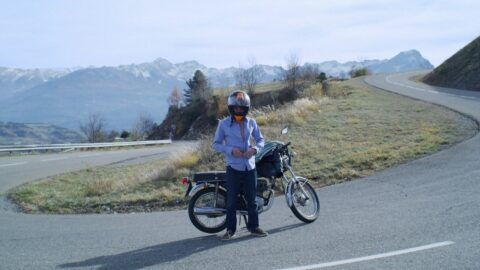The opening shots of writing/directing trio Anton Balekdjian, Léo Couture and Mattéo Eustachon’s delightful new existential dramedy Drifting Laurent (2025) perfectly capture the film’s tone: a close-up of feet dangling in the air — likely from a parachute or paraglider — hovering above Alpine terrain, slowly descending to Earth. We soon learn that our slightly troubled, aimless protagonist probably didn’t skydive into the quiet ski resort town; he’s shown dragging suitcases in search of lodging. The image becomes a gently surreal metaphor for his life — floating, unsatisfied with the 9-to-5 routine, in desperate need of a place to call home.
Newcomer Baptiste Perusat is Laurent, a 29-year-old, laid-back everyman with an easygoing charm. He arrives during the offseason, temporarily staying in an apartment owned by his sister’s girlfriend’s family. With only a short window before he has to move out, the film follows Laurent as he searches for more permanent housing, explores the area, and meets some of the village’s eccentric residents, including Lola, a sick elderly woman living alone in a hoarder’s home, and Sophia (Béatrice Dalle), along with her Viking-obsessed son, Santiago (Thomas Daloz).
Much like last year’s sleeper hit, Misericordia (Alain Guiraudie, 2024) — a darkly comic thriller about a gay man drawn into a murder mystery while visiting his hometown for a funeral — Drifting Laurent gently satirises small-town life with a dry, understated humour. But unlike Misericordia, which leans more sharply critical and at times caustic, Drifting Laurent approaches its rural setting with quiet empathy. The townspeople are portrayed as eccentric but never absurd, lonely but not pathetic, and ultimately seeking the same kind of connection as Laurent. While their livelihoods depend on seasonal tourism, the film emphasises that their lives hold meaning and emotional depth beyond economic survival.
At one point, Laurent encounters a man searching for his “magical” goat, said to produce milk year-round. Instead of turning this into a whimsical detour into magical realism, the film uses it as a metaphor for the town itself. As one man explains, something is deemed “magical” if it can generate a product — and income — all year long, which the town simply can’t. Tourists only come in winter, when there’s snow, and the rest of the year, the village struggles to stay afloat. It’s a sly, ironic commentary on the relentless pressure to be constantly productive — whether it’s people, places or even animals. For Laurent, it mirrors his own internal battle with those same demands.
Yet the film’s approach to sexuality is refreshing and casual, reflecting the “it’s just not a big deal” attitude often seen among younger generations. Laurent’s bisexuality — revealed during an almost-hookup with a witty young photographer (Djanis Bouzyani) he meets while exploring the region — and his sister’s lesbian relationship aren’t treated as major plot points. They simply exist without fanfare. Without giving too much away, Laurent also has a liaison with a much older character, and the filmmakers offer no judgment about the age gap. For Laurent, sex is just one of the many forms of intimacy he’s exploring — and he finds it in several different ways.
Drifting Laurent won’t be for everyone — its slow, meandering pace may deter more casual viewers — but those who stick with it will find a film with a big, beating heart beneath its initially melancholic and detached surface. It speaks to the misfits, the confused, the aimless and the lonely — those searching for something more than a comfortable, picture-perfect life that looks good on paper but feels empty of soul or purpose.
Editor-at-large Jared loves movies and lives with Kiki in Berlin.

